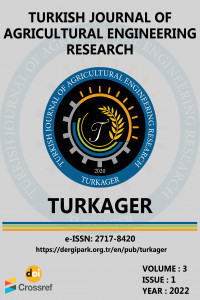Determination of the Proximate Composition and Amylose Content of New Rice for Africa (NERICA) Flour
Determination of the Proximate Composition and Amylose Content of New Rice for Africa (NERICA) Flour
NERICA, Proximate composition, amylose content, rice rice centre,
___
- AACC (2001). American Association of Cereal Chemists. Approved methods of the AACC (10th ed.) Methods 10-09, 39-11, 39-06, 54-21, and 74-09. St. Paul, MN: AACC. AOAC (2005). Association of Official Agricultural Chemists. Approved methods of the AOAC (18th ed.). Adebayo-Oyetoro AO, Olatidoye OP, Ogundipe OO, Balogun OI, Bamidele FA and Faboya AO (2011). Evaluation of proximate composition and functional properties of Ofada rice (Oryza sativa) flour blended with bambara groundnut (Vigna subterannea L.). IOSR Journal of Agriculture and veterinary Science, 3: 60-66. Egounlety M and Aworh DC (1990). Production and physico-chemical properties of Tempeh fortified maize based weaning food. Nigerian Food Journal, 70: 92-102. Eze PC and Oluka SI (2014). Selected Physical and Aerodynamics Properties of NERICA (New Rice for Africa). Journal of Agricultural Engineering and Technology (JAET), 22 (3): 47- 60. Eze PC, Oluka SI, and Eze CN (2020). Effect of Moisture Content and Loading Positions on the Mechanical Properties of New Rice for Africa (NERICA). Scientific Journal of Agricultural Engineering (SJAE), 1 (1): 38-50. Falade KO and Christopher AS (2015). Physical, functional, pasting and thermal properties of flours and starches of six Nigerian rice cultivars. Food Hydrocolloid, 44: 478-490. Fukushima K, Sogo K, Miura S and Kimura Y (2004). Production of D-lactic acid by bacterial fermentation of rice starch. Macromolecular Bioscience, 4: 1021-1027. Funami T, Kataoka Y, Omato T, Goto Y, Asai I, and Nishinari K (2005). Food hydrocolloids control the gelatinization and retrogradation behaviour of starches and functions of guar gums with different molecular weights on the gelatinization behaviour of corn starch. Food Hydrocolloids, 19: 15-24. Hagenimana A, and Ding X (2005). Preparative study on pasting and hydration properties of starches and their mixtures. Cereal Chemistry, 82: 70-78. Hoover R (2001). Composition, molecular structure, and physicochemical properties of tuber and root starches: a review. Carbohydrate Polymers, 45: 253-267. Hu EA, Pan A, Malik V, and Sun Q (2012). White rice consumption and risk of type 2 diabetes: Meta-analysis and systematic review. British Medical Journal, 344, e1454. ICC (2017). International Association for Cereal Science and Technology. Approved methods of the ICC (Generic Methods), Method 168 Ituen EU and Ukpakha AC (2011). Improved Method of Parboiling Paddy for better quality rice. World Journal of Applied Science and Technology, 3(1): 31-40. Iwe MO, Onyeukwu U, and Agiriga AN (2016). Proximate, functional and pasting properties of FARO 44 rice, African yam bean and brown cowpea seeds composite flour. Cogent Food & Agriculture, 2 (1): 1142409. Jideani VA (2011). Functional Properties of Soybean Food Ingredients in Food Systems; Soybean – Biochemistry and Physiology, Prof. Tzi-Bun Ng (Ed.), ISBN: 978-953-307-219-7, InTech. Kraithong S, Lee S and Rawdkuen S (2018). Physicochemical and functional properties of Thai organic rice flour. Journal of Cereal Science, 79: 259-266. Oko AO, and Ugwu SI (2011). The proximate and mineral compositions of five major rice varieties in Abakaliki, South-Eastern Nigeria. International Journal of Plant Physiology and Biochemistry, 3: 25-27. Raja KCM and Ramakrishna SU (1990). Compositional and pasting characteristics of plain-dried and parboiled cassava (Manihot esculenta crantz). Food Chemistry, 38: 79-88. Reebe S, Gonzalez VN and Rengifo J (2000). Research on trace elements in common beans. Food Nutrition Bulletin, 21: 387-391. Sievert D and Holm JH (1993). Determination of amylose by differential scanning calorimetry. Starch - Stärke, 45: 136-139. Singh KK and Goswami TK (2000). Thermal properties of cumin seed. Journal of Food Engineering, 45: 181-187. Sotelo A, Saisa V Montolvo, I., Hernandez M and Hernandez L (1990). Chemical composition of different fractions of 12 Mexican varieties of rice obtained during milling. Cereal Chemistry, 67: 209-212. Udemezue JC (2018). Analysis of Rice and Consumption Trends in Nigeria. Journal of Plant Science and Crop Protection,1 (3): 1-6. Wang L, Guo J, Wang R, Shen C, Li Y, Luo X, Li Y and Chen Z (2016). Studies on quality of potato flour blends with rice flour for making extruded noodles. Cereal Chem. 93; Pp: 593-598. Wani AA, Singh P, Shah MA, Schweiggert-Weisz U, Gul K and Wani IA (2012). Rice Starch Diversity: Effects on Structural, Morphological, Thermal, and Physicochemical Properties- A Review. Comprehensive Reviews in Food Science and Food Safety, 11; Pp: 417-436. WARDA (2008). West Africa Rice Center/FAO/SAA issues on NERICA; the New Rice for Africa, a Compendium. E.A. Samado, R.G. Guei and S.O. Keya (eds). Cotonu, Benin. Africa Rice Centre (WARDA); Rome, Italy; FAO; Tokyo, Japan: Sasakawa Africa Association; Pp: 210. Whistler RL, and BeMiller, J.N. (1997). Carbohydrate chemistry for food scientists. St. Paul, Minn.: Eagan Press.
- Yayın Aralığı: Yılda 2 Sayı
- Başlangıç: 2020
- Yayıncı: Ebubekir ALTUNTAŞ
A Review on Inter-row Crops Mechanical Weeder
Adewale SEDARA, Oluwadunsin SEDARA
Rüveyda YÜZBAŞIOĞLU, Esra KAPLAN
Effects of Tillage Systems on Energy Efficiency in Safflower Farming of Central Anatolia of Turkey
Ebubekir ALTUNTAŞ, Engin ÖZGÖZ, Mustafa GÜZEL, Bülent ÖZGENLİK
Abdullah BEYAZ, Mustafa VATANDAŞ
Türkiye Yem Bitkileri Tarımına Karşılaştırmalı Genel Bakış ve Değerlendirme
Termal Stres Altında Yetiştirilen Küçükbaş Hayvanlarda Kısıtlı Su Uygulamasının Etkileri
Response Surface Optimization of Convective Air Drying Process in a Hybrid PV/T Solar Dryer
Sampson UZOMA, Nnaemeka NWAKUBA, Kelechi ANYAOHA
Genç Çiftçi Proje Desteğinden Yararlanmayı Etkileyen Faktörler TR-83 Bölgesi Örneği
Gülçin ALTINTAŞ, Atila ALTINTAŞ, Esen ORUC, Halil KIZILASLAN, Erol ÇAKMAK, Duygu BİROL
